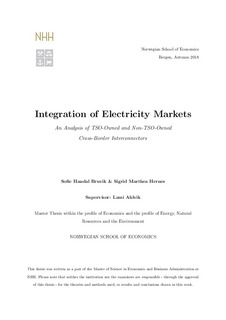Integration of electricity markets : an analysis of TSO-owned and non-TSO-owned cross-border interconnectors
Master thesis
Permanent lenke
http://hdl.handle.net/11250/2586733Utgivelsesdato
2018Metadata
Vis full innførselSamlinger
- Master Thesis [4372]
Sammendrag
The European electricity market is gradually becoming more integrated due to increased crossborder
transmission capacity. Integrated electricity markets are expected to improve social
welfare through security of supply and e cient electricity generation. Thus, inadequate crossborder
transmission capacity causes an ine cient allocation of resources at a regional level.
The integration of electricity markets will impact electricity prices and the social welfare in the
connected regions. A cross-border interconnector between the bidding zone NO5 in Norway
and the market area Great Britain will exploit the di erent price levels and structures of the
regions. The interconnector is expected to increase electricity prices in NO5 and decrease
electricity prices in Great Britain. Further, the social welfare is expected to increase in both
NO5 and Great Britain.
This thesis estimates the annual congestion rent of a 1 400MWinterconnector between NO5 and
Great Britain. The Norwegian share of the congestion rent is estimated to vary between e51,4
million and e168,4 million in the period from 2026 to 2045. To account for the uncertainty in the
future price di erential between the two power markets, the range of the estimated congestion
rent is constructed from the positively skewed distribution of the historical price di erential
from 2011 to 2017. This thesis nds that the range of the estimated congestion rent is expected
to di er greatly from the baseline. Moreover, alteration in the electricity mix of power markets
and additional cross-border interconnectors are identi ed as sources of uncertainty for the future
price di erential, which in turn will impact the congestion rent.
This thesis argues that a non-TSO investor will under-provide cross-border transmission capacity
relative to what is socially desirable on a national level. Moreover, the capacity decision of
a non-TSO investor is a ected by the income regulation of the interconnector. If national regulatory
authorities wish to encourage non-TSO investments in transmission capacity, the income
regulation of interconnectors must be in the favour of the interconnector owners. Further, the
income regulation must account for the uncertainties in the future price di erential. This thesis
identi es a su ciently high revenue cap, an extended settlement period, an incorporation of a
revenue
oor and a higher allowed share of revenues derived from capacity markets as possible
solutions to incentivise non-TSO investments in interconnectors through income regulation.
